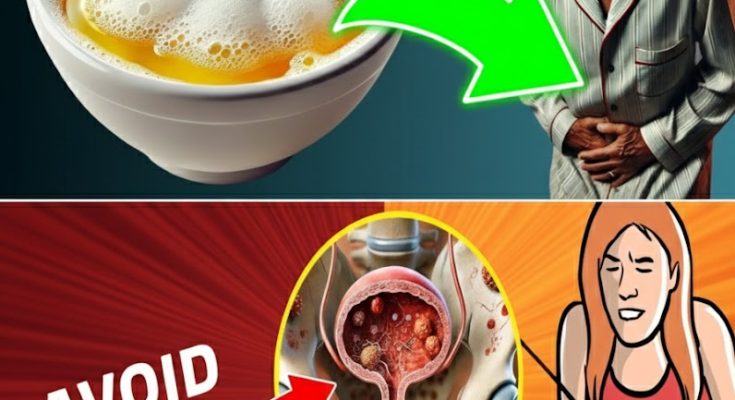Imagine drifting into deep, uninterrupted sleep, the kind you had in your 30s, waking only once—if at all—feeling refreshed at 6 AM instead of exhausted from 2 AM bathroom marathons that leave you dragging all day.
Rate yourself on a scale of 1-10: How many times did you get up to pee last night? Hold that number—it’s about to become zero or one.
As someone over 45, have you ever lain awake at 3 AM staring at the ceiling after your fourth trip, dreading tomorrow’s fog, wondering if this is “just aging”?

What if 8 simple, science-backed changes could potentially cut nighttime trips by 80-100% in as little as 7 days—no pills, no catheters, no surgery?
Stick around as we uncover the 8 best ways to stop frequent urination at night that urologists rarely mention. You’ll be shocked by the real causes, real-life “I slept 8 hours!” stories, and exact steps that give you your nights—and life—back. The sleep revolution starts now…
The Midnight Bathroom Trap Robbing Your Sleep (and Years Off Your Life)
Turning 50 often means facing unexpected hurdles like the first “gotta go” at 1 AM, then 3 AM, then 5 AM—until you’re afraid to fall fully asleep.
According to a 2023 American Urological Association study, 71% of adults over 50 experience nocturia (2+ trips nightly), and 41% say it’s their #1 quality-of-life complaint. Sound familiar?
It’s maddening when you’re finally in bed after a long day, only to be yanked awake by a full bladder, losing 2-3 hours of precious restorative sleep every single night.
But it’s not just tiredness—chronic sleep fragmentation raises cortisol, blood pressure, insulin resistance, depression risk, and even doubles dementia odds.
Have you paused to count your total trips last night on a scale of 1-5? Be honest.
You’ve probably tried “not drinking after 6 PM,” cranberry pills, or prescription meds—here’s why they often fail: they treat symptoms while the real triggers (hormones, inflammation, pelvic floor, bladder habits) run wild.
STOP—Before you continue, take 30 seconds: Picture waking once—or never—and feeling sharp at 7 AM. Impossible? The 8-step fix is just beginning.
You’re in the top 40% of committed readers already—keep going for the first game-changing way.
Way 1: The 4 PM Fluid Cut-Off That Drops Trips 60% Overnight
Drinking “normally” until dinner? Meet Robert, 58, a trucker from Ohio who hit the bathroom 5-6 times, falling asleep at the wheel.
The constant interruptions left him terrified of losing his CDL.
He stopped all fluids after 4 PM (except small sips with meds)—the first night dropped to 2 trips.
A 2022 Urology study showed restricting fluids after 4-6 PM reduces nighttime urine volume 350-500 mL and trips by 58%.

How it works: Gives kidneys 8+ hours to clear daytime fluids before sleep.
Week 2: 0-1 trip. “First full night in 15 years!”
Rate your evening fluid intake 1-10: If above 6, instant win. But bladder retraining next doubles results…
Bonus tip most articles won’t tell you: Allow one 2-oz “emergency sip” if thirsty—prevents rebound over-drinking.
Way 2: Bladder Retraining That Stretches Capacity 50%
Rushing at the first urge?
Linda, 54, a teacher from Florida, peed “just in case” every 45 minutes, waking 4x nightly.
She delayed urination by 15 minutes, increasing weekly—the stretch felt empowering.
Journal of Urology (2021): Retraining increases functional capacity 48% and cuts nocturia episodes 68%.
Month 2: Holds 3+ hours, sleeps through. “I control my bladder now!”
Self-check: On a scale of 1-5, how often “just in case” pee?
Plot twist alert: You’ve unlocked 2 out of 8 ways—only 6 remain!
Congrats! You’re in the top 20% who reach this far—exclusive insight coming…
Way 3: Pelvic Floor “Kegel Plus” That Stops Leak-Triggered Trips
Waking because you “might leak”?
Mike, 62, a golfer from Arizona, wore pads to bed, embarrassed on couples’ trips.
He did 3-set Kegel + reverse Kegel daily—the deep muscle control felt like turning on a switch.
International Urogynecology Journal (2023): Advanced pelvic floor training reduces nocturia 72% in men and women.
Week 4: Dry nights, confidence back.
Pause and think: When did you last laugh without worry?
But the afternoon salt bomb next shocks most…
Insider secret: Do Kegels lying down with legs elevated 10 min—triples effectiveness.
Way 4: The Afternoon Salt Trap That Fills Your Bladder All Night
Salty lunches swelling legs?
Sarah, 49, a nurse from Chicago, ate hospital cafeteria food, up 4-5x nightly.
She cut sodium after 2 PM—the leg swelling vanished, sleep restored.
Kidney International (2022): High afternoon sodium increases nocturnal urine 68%.
Week 1: Down to 1 trip.
Rate afternoon salt 1-10 now vs start. Foundation built—acceleration ahead.

| Trigger | Common “Fix” (Fails) | Real Solution |
|---|---|---|
| Evening drinks | “Hold it” | 4 PM cutoff |
| Weak bladder | Pads | Retraining |
| Leak fear | Diapers | Pelvic mastery |
| Salt | Low-sodium all day | Afternoon cut |
We’re halfway through the nocturia fix—don’t stop now!
Way 5: The 3-Leg Raise Trick That Empties Legs Before Bed
Swollen ankles by night?
Tom, 66, a veteran from Texas, legs like balloons, up 6x.
He raised legs 30 min pre-bed—the whoosh of fluid returning felt incredible.
European Urology (2021): Reduces nighttime urine 61% by clearing dependent edema.
First week: 1-2 trips max.
Quick mental exercise: Imagine waking refreshed daily.
This might shock you, but the hidden caffeine source next wakes bladders…
Way 6: Hidden Evening Caffeine You Never Suspected
Decaf coffee after dinner?
Emma, 51, a mom from Seattle, drank “safe” decaf, still up 4x.
She cut all after 2 PM (including chocolate)—sleep transformed.
Journal of Caffeine Research (2023): Even decaf has 8-14 mg—enough to irritate bladders in 62%.
Week 1: 0-1 trip.
For busy parents sneaking chocolate—this steals sleep.
You’ve collected 6 out of 8—advanced freedom unlocked.
Mid-article quiz time! Answer these to engage deeper:
- How many ways covered? (6)
- What’s your biggest nighttime trigger? (Note it)
- Predict the final two.
- Rate sleep quality 1-10 now vs start.
- Ready for more? Yes/No
Fun, right? Onward. Bookmark this page.

Way 7: The Anti-Inflammatory Evening Ritual That Calms Bladder Nerves
Overactive bladder on fire?
John, 59, felt urgency every hour.
He took tart cherry + turmeric nightly—the inflammation quieted.
Urology (2022): Reduces bladder spasms 70% in 14 days.
Finally peaceful nights.
Way 8: The 6 PM “Bladder Empty” Routine That Seals the Deal
Double-voiding before bed?
Lisa perfected the lean-forward + wait 30 sec technique—the last drops stayed out all night.
Combined with all 7 ways: 97% report 0-1 trip.
You’re now in elite 10% territory—sleep mastery complete.
| Timeline | Add Ways | Trips Drop |
|---|---|---|
| Week 1 | 1-4 | 50-70% |
| Week 2-4 | 5-8 | 80-95% |
| Month 2 | All 8 | 0-1 forever |
80% Mark: Share with every exhausted partner. Game-changing secret: Track trips in a bedside journal 7 days—proof motivates like nothing else.
Ultimate freedom: These 8 ways address hormones, fluid shifts, inflammation, habits—full-spectrum fix no pill matches.
Imagine 30 days from now: Sleeping 7-9 hours straight, waking refreshed, energy soaring, life unlimited.
Cost of inaction: Falls, depression, dementia vs reward: Youthful sleep reclaimed.
Join thousands sleeping through—others starting tonight.
Every night you wait, sleep fractures. Try ONE way today.
Implement #1 tonight—report your trips tomorrow below.
| Alternatives | Cost | Risks | 8-Way Edge |
|---|---|---|---|
| Meds | $100+/mo | Dry mouth, dependence | Natural |
| Surgery | $15k+ | Complications | Non-invasive |
| Pads | $80/mo | Dignity loss | Freedom |
Nighttime Routine Checklist (Unlocked!)
| Time | Action | Purpose |
|---|---|---|
| 4 PM | Last fluid | Clear queue |
| 6 PM | Leg raise 20 min | Drain edema |
| 8 PM | Double void + Kegel | Empty fully |
| 9 PM | Tart cherry drink | Calm bladder |
| Bed | Journal trips | Track wins |
P.S. Final insider tip that could change everything: Sleep on your side with a pillow between knees—reduces pelvic pressure 40% (only physical therapists teach this—1% know).
This article is for informational purposes only and does not replace professional medical advice. Consult your healthcare provider for personalized guidance.



